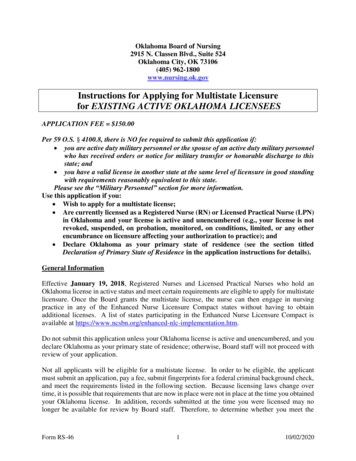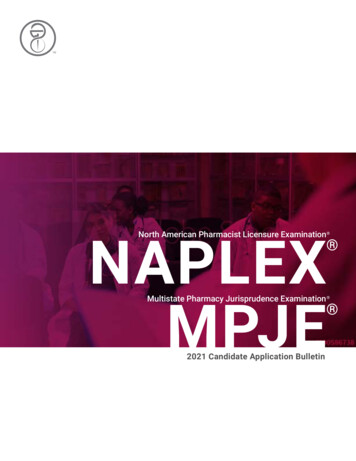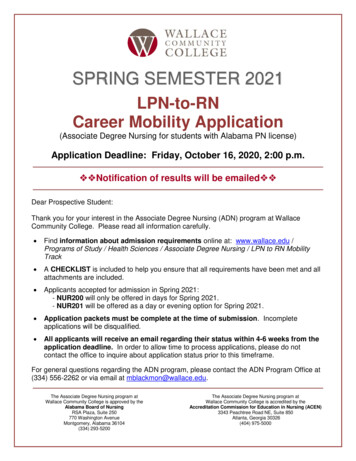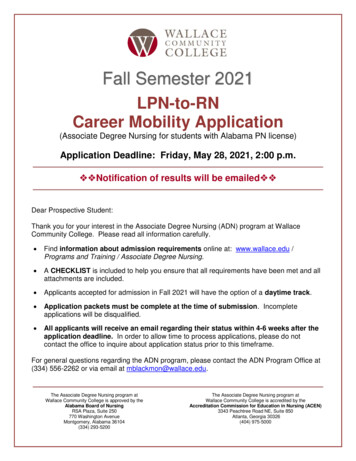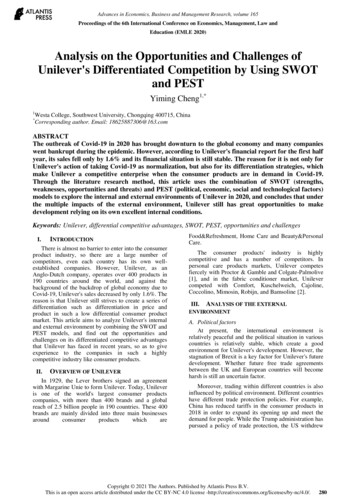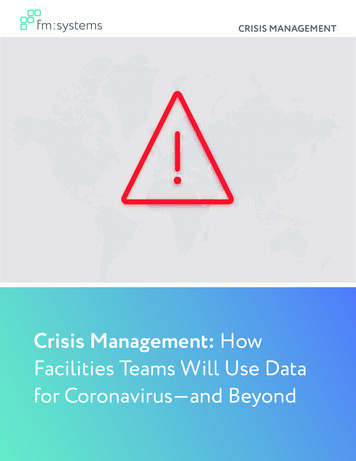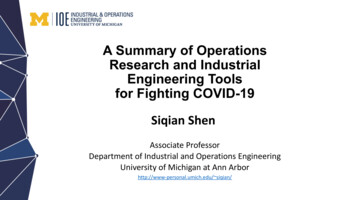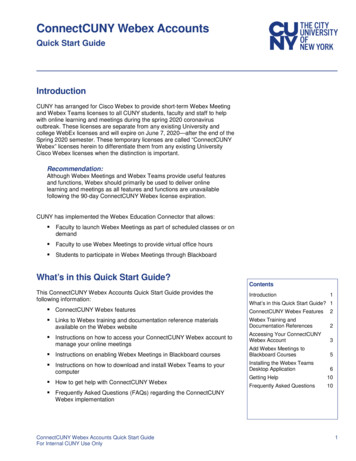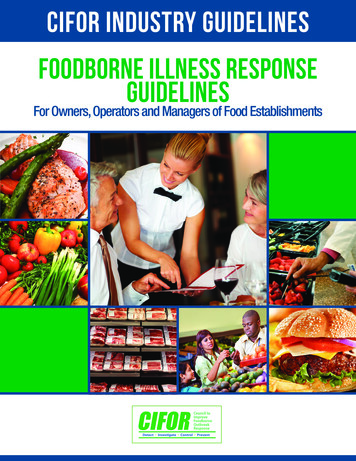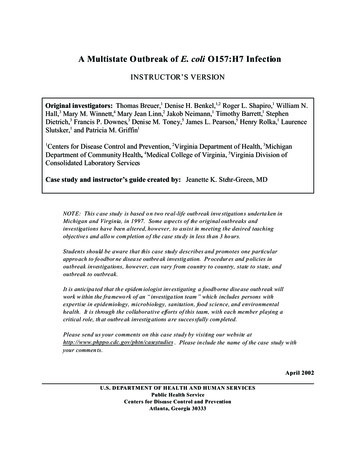
Transcription
A Multistate Outbreak of E. coli O157:H7 InfectionINSTRUCTOR’S VERSIONOriginal investigators: Thomas Breuer,1 Denise H. Benkel,1,2 Roger L. Shapiro,1 William N.Hall,3 Mary M. Winnett,4 Mary Jean Linn,2 Jakob Neimann,1 Timothy Barrett,1 StephenDietrich,3 Francis P. Downes,3 Denise M. Toney,5 James L. Pearson,5 Henry Rolka,1 LaurenceSlutsker,1 and Patricia M. Griffin1Centers for Disease Control and Prevention, 2Virginia Department of Health, 3MichiganDepartment of Community Health, 4Medical College of Virginia, 5Virginia Division ofConsolidated Laboratory Services1Case study and instructor’s guide created by: Jeanette K. Stehr-Green, MDNOT E: This c ase study is based o n two re al-life outb reak inve stigation s underta ken inMichigan and Virginia, in 1997. Some aspects of the original outbreaks andinvestigations have been altered, however, to assist in meeting the desired teachingobjective s and allo w com pletion o f the case stu dy in less th an 3 ho urs.Students should be aware that this case study describes and promotes one particularappro ach to fo odbor ne disea se outbre ak investig ation. Pr ocedur es and p olicies inoutbreak investigations, however, can vary from country to country, state to state, andoutbreak to outbreak.It is anticipa ted that th e epidem iologist inv estigating a foodb orne dise ase outb reak willwork w ithin the fra mewo rk of an “ investiga tion team ” which includes persons withexpertise in epidemiology, microbiology, sanitation, food science, and environmentalhealth. It is through the collaborative efforts of this team, with each member playing acritical role, th at outbre ak investig ations a re succes sfully com pleted.Please send us your comments on this case study by visiting our website athttp://www.phppo.cdc.gov/phtn/casestudies. Please in clude the name of the case study w ithyour commen ts.April 2002U.S. DEPARTMENT OF HEALTH AND HUMAN SERVICESPublic Health ServiceCenters for Disease Control and PreventionAtlanta, Georgia 30333
Target audience: epidemiologists and other persons with knowledge of basic epidemiologicconcepts and experience in data collection and analysis who are interested in learning specificskills for investigating infectious disease outbreaksTraining prerequisites: descriptive epidemiology, epidemic curves, measures of association,study design, outbreak investigation. The student will also benefit from having some familiaritywith food microbiology and environmental investigation techniques but will be likely to relyheavily on others with greater expertise in these areas in a real-life outbreak situation.Teaching materials required: calculatorTime required: approximately 2 hours and 30 minutesLanguage: EnglishLevel of case study: BasicIntermediate XAdvancedMaterials borrowed from:“Foodborne Illness Investigation and Control Reference Manual”, Massachusetts Department ofPublic Health, Division of Epidemiology and Immunization, Division of Food and Drugs, andDivision of Diagnostic Laboratories (1997)“Guidelines for the Investigation and Control of Foodborne Disease Outbreaks”, World HealthOrganisation, Food Safety Unit Division of Food and Nutrition and Division of Emerging andOther Communicable Diseases Surveillance and Control (DRAFT, 1999)Reviewed by:Richard Dicker, MD, MPH, Centers for Disease Control and PreventionSteve Luby, MD, MPH, Centers for Disease Control and PreventionRob Tauxe, MD, MPH, Centers for Disease Control and PreventionChris Zahniser, RN, MPH, Centers for Disease Control and PreventionPatty Griffin, MD, MPH, Centers for Disease Control and PreventionSharon McDonnell, MD, MPH, Centers for Disease Control and PreventionThomas Grein, MD, MPH, World Health OrganizationCraig Hedberg, PhD, University of MinnesotaMichael Beach, PhD, Centers for Disease Control and PreventionAdriana Lopez, MPH, Centers for Disease Control and PreventionDenise Werker, MD, MHSc, FRCPC, Laboratory Centre for Diseases Control, Health CanadaCover art by: Barbara Orisich, MSTraining materials funded by: the Centers for Disease Control and Prevention (NationalCenter for Infectious Diseases, Food Safety Initiative, Public Health Practice Program Office,and Epidemiology Program Office/Division of International Health)
INSTRUCTOR’S VERSIONA Multistate Outbreak of E. coli O157:H7 InfectionLearning objectives:After completing this case study, the student should be able to:1.describe the unique role the laboratory can play in the detection and investigation of afoodborne disease outbreak2.perform in-depth interviews of selected case-patients to generate hypotheses about thesource of an outbreak and mode of transmission3.determine the most efficient epidemiologic study design to test a hypothesis (includingthe case definition and appropriate comparison group)4.list three ways to select a comparison group for a study and the advantages anddisadvantages of each method5.list detailed product information that will facilitate a traceback procedure6.discuss the relative merits of an intervention based on changes in product processing(or design) versus changes in consumer or producer behaviorsPART I - OUTBREAK DETECTIONEscherichia coli O157:H7 was first identified as a human pathogen in 1982 in the United Statesof America, following an outbreak of bloody diarrhea associated with contaminated hamburgermeat. Sporadic infections and outbreaks have since been reported from many parts of the world,including North America, Western Europe, Australia, Asia, and Africa. Although other animalsare capable of carrying and transmitting the infection, cattle are the primary reservoir for E. coliO157:H7. Implicated foods are typically those derived from cattle (e.g., beef, hamburger, rawmilk); however, the infection has also been transmitted through contact with infected persons,contaminated water, and other contaminated food products.Infection with E. coli O157:H7 is diagnosed by detecting the bacterium in the stool. Mostlaboratories that culture stool do not routinely test for E. coli O157:H7, but require a specialrequest from the health care provider. Only recently has E. coli O157:H7 infection becomenationally notifiable in the U.S. Outside the U.S., reporting is limited to a few but increasingnumber of countries.In the last week of June 1997, the Michigan Department of Community Health (MDCH) noticedan increase in laboratory reports of E. coli O157:H7 infection. Fifty-two infections had beenreported that month, compared with 18 in June of 1996. In preliminary investigations, noobvious epidemiologic linkages between the patients were found. The increase in casescontinued into July.
A Mu ltistate Ou tbreak o f E. coli O157:H7 InfectionInstructor ’s Versio n - p. 2Question 1A: What could account for the increase in cases reported to MDCH?It may be useful to categorize reasons for the increase as those causing an “artificial (orperceived) increase” in number of infections vs. those causing a “real increase”.Artificial increase: increased culturing of stools initiation of new testing by the laboratory (i.e., lab did not undertake necessaryprocedures to isolate this organism in the past) laboratory error in identification contamination of cultures changes in reporting procedures errors in data entryReal increase: an increase in population size changes in population characteristics (with an influx of persons at higher risk for theinfection) an increase in rate of infection due to random variation (fluctuation) in incidence (i.e.,chance) an increase in rate of infection due to an outbreak (NOTE: This latter situation couldresult from a common source exposure or an increase in behaviors [e.g., outdoorcooking] that lead to increased infections from a variety of sources.)Question 1B: What information might help determine which of these explanations is the mostlikely cause of the increased numbers?If not already known, it would be helpful to consult with staff from the laboratory andsurveillance section (and other key informants) to collect the following information: changes in local laboratory procedures or staff if problems with stool culturing have been identified changes in physician diagnostic practices changes in laboratory or physician reporting practices (e.g., changes in mandatoryreporting requirements, recent efforts to increase reporting through provider education) changes in population demographics characteristics of cases (e.g., clustering in space, time, or person) subtyping of the isolates to see if they are the same/related
A Mu ltistate Ou tbreak o f E. coli O157:H7 InfectionInstructor ’s Versio n - p. 3Laboratory subtyping can help determine if an increased number of isolates of the same bacterialspecies results from a common source outbreak. Subtyping methods are based on selectedbiologic and/or genetic characteristics of bacteria that tend to differ between isolates of the samespecies. In a common source outbreak, however, isolates typically arise from the same parentorganism. These isolates will be similar to each other with respect to these biologic and geneticcharacteristics and have similar subtyping results.One subtyping method is DNA"fingerprinting" by Pulsed Field GelElectrophoresis (PFGE). In DNAfingerprinting, the bacterial DNA is cut intopieces. The pieces are separated by placingthem in a jelly-like substance (i.e., the gel),acting as a sieve, to which a pulsing electricfield is applied. The electric field drives theDNA pieces across the gel over a period ofhours. The smaller pieces move through thegel more quickly and the larger pieces moreslowly resulting in a separation of the DNAinto distinct bands. The bands are made tofluoresce and are read under ultravioletillumination. This DNA “fingerprint”resembles a bar code. (Figure 1)Figure 1. Typical DNAbanding p atternresulting from PFGE.Different DNA composition will result in different PFGE banding patterns. Bacteria descendedfrom the same original parent will have virtually identical DNA and their DNA fingerprints willbe indistinguishable. Identification of a cluster of isolates with the same PFGE pattern suggeststhat they arose from the same parent and could be from the same source.Similar DNA fingerprints alone, however, are insufficient to establish a linkage between isolatesand a common source outbreak. An epidemiologic investigation is necessary to demonstrate thatthere is a common source and to identify it. To be most useful, PFGE subtyping needs to beperformed on a routine basis, in real time, so that results are available (and reviewed) soon after acase is first detected.
A Mu ltistate Ou tbreak o f E. coli O157:H7 InfectionInstructor ’s Versio n - p. 4Question 2: Compare the DNA fingerprints in Figure 2 from seven of the Michigan E. coliO157:H7 cases. Each isolate has its own vertical lane (i.e., column). Controls appear in lanes#1, 5, and 10. Which Michigan isolates appear similar?Figure 2. PFGE results on E. coli O157:H7 isolates from Michigan, June-July 1997.Typically, a PFGE “pattern” is defined as having the same banding pattern but including up toone band difference. By this definition, isolates #2, 3, 4, 6, and 7 are indistinguishable by thesePFGE results. (Isolate #4 differs by one band.)NOTE: To facilitate routine examination of PFGE results, the U.S. Centers for Disease Controland Prevention (CDC) is currently equipping State Public Health Laboratories with the capacityto perform and compare PFGE results on selected foodborne pathogens. Laboratoriesparticipating in the network, called PulseNet, perform PFGE on disease-causing bacteriaisolated from humans and suspected food using standardized equipment and methods. Once
A Mu ltistate Ou tbreak o f E. coli O157:H7 InfectionInstructor ’s Versio n - p. 5PFGE patterns are generated, they are entered into an electronic database of DNA"fingerprints" at the state or local health department and transmitted to CDC where they arefiled in a central computer. The system will ultimately be developed into a national onlinedatabase. If patterns submitted by laboratories in different locations during a defined timeperiod are found to match, the CDC computer will alert PulseNet participants of a possiblemultistate outbreak so that a timely investigation can be done.DNA fingerprinting, performed in the MDCH State Laboratory during the second week of Julyshowed that 17 of the first 19 E. coli O157:H7 isolates from June-July were indistinguishable.They did not match any fingerprints from a convenience sample of isolates from patients with E.coli O157:H7 infection before May.Based on the PFGE findings, MDCH suspected the cases of E. coli O157:H7 infection resultedfrom a common source. On July 15, MDCH initiated an investigation. The Centers for DiseaseControl and Prevention (CDC) was asked to join the investigation.
A Mu ltistate Ou tbreak o f E. coli O157:H7 InfectionInstructor ’s Versio n - p. 6PART II - DESCRIPTIVE EPIDEMIOLOGY AND HYPOTHESIS GENERATIONThe incubation period for E. coli O157:H7 ranges from 3-8 days with a median of 3-4 days. Theinfection often causes severe bloody diarrhea and abdominal cramps, but can also cause anonbloody diarrhea or result in no symptoms. In some persons, particularly children under 5years of age and the elderly, the infection can cause a complication called hemolytic uremicsyndrome, in which the red blood cells are destroyed and the kidneys fail. About 2-7% ofinfections lead to this complication.For the outbreak investigation in Michigan, a case was defined as diarrhea ( 3 loose bowelmovements a day) and/or abdominal cramps in a resident of Michigan with onset of symptomsbetween June 15 and July 15 and a stool culture yielding E. coli O157:H7 with the outbreakstrain PFGE pattern.Question 3: What are the advantages and disadvantages of this case definition? How might youchange it?A case definition is a standard set of criteria for deciding whether an individual should beclassified as having the disease of interest. A case definition includes clinical criteria (e.g.,signs, symptoms, and laboratory tests) and restrictions on time, place, and person.For the case definition used in the Michigan investigation:Advantages: Lab confirmation will increase the specificity of the case definition (and exclude casesthat might not be related to the outbreak). This reduces misclassification and maximizesthe power to detect a source of the outbreak.Disadvantages: Lab confirmation will exclude patients who did not see a doctor, patients who were notcultured, and cultured patients without PFGE testing. Lab confirmation will decrease thesensitivity of the case definition and, possibly, lead to a misrepresentation of casecharacteristics. Limiting cases to Michigan residents may be practical from the standpoint of a statebased investigation but may exclude visitors who became infected or inhibit investigatorsfrom recognizing an extension of the outbreak into other states.We are not given enough information to say whether the dates are reasonable. A line listing ofcases might be helpful. Confining the dates of onset to June 15-July 15 could limit the number ofsecondary cases (e.g., person-to-person transmission) included in the study that could interferewith identification of the initial source of the outbreak.
A Mu ltistate Ou tbreak o f E. coli O157:H7 InfectionInstructor ’s Versio n - p. 7The general purpose of including symptoms (as well as laboratory confirmation) in the casedefinition for gastrointestinal illnesses is to exclude persons who are chronic carriers of theinfection (such as for salmonellosis). It is unlikely to impact this study, however, since mostpersons with E. coli O157:H7 will have symptoms and prolonged carriage of E. coli isuncommon.Of the initial 38 persons who met the case definition, 26 (68%) were female with a median age of31 years. (Table 1)Table 1. Age group and gender distribution for persons with E. coli O157:H7 infection and the outbreakPFGE pattern, Michigan, June 15 - July 15, 1997. (N 38)Age group(years)GenderTOTALMaleFemale0-92 (17%)*2 (8%)4 (11%)10-192 (17%)3 (12%)5 (13%)20-393 (25%)9 (35%)12 (32%)40-592 (17%)8 (31%)10 (26%)60 3 (25%)4 (15%)7 (18%)12 (101%)26 (101%)38 (100%)TOTAL* percentages refer to column totals.Question 4: Compare the age and gender distribution of E. coli O157:H7 cases from theMichigan outbreak and those reported from U.S. FoodNet sites in 1997. (see Appendix 1)It may help to have students graph the two age-gender distributions to facilitate theircomparison.Among cases reported to FoodNet in 1997, the male:female ratio was similar (1:1.1). Rates ofinfection were highest among children and declined with increasing age (until about 50 years ofage where rates again increased). In contrast, the cases in Michigan (with the outbreak PFGEpattern) were more common among adult females, 20-59 years of age. This age and gender
A Mu ltistate Ou tbreak o f E. coli O157:H7 InfectionInstructor ’s Versio n - p. 8distribution may suggest an unusual source of infection such as a product used more commonlyby young or middle-aged women. It might also be consistent with infection among mothersexposed to diapered children, although one would expect to see more cases among children inthat situation.The 38 cases of E. coli O157:H7 infection meeting the investigation case definition werereported from 10 counties in the lower peninsula of Michigan. Onset of illness occurred frommid-June to mid-July, peaking on June 22. (Figure 3)Figure 3. Date of illness onset for persons with E. coli O157:H7 infection and the outbreak PFGEpattern, Michigan, June 15 - July 15, 1997. (N 38)From July 16 - 19, hypothesis-generating interviews were undertaken with seven patients. Thesepatients lived in four different counties and ranged in age from 5-69 years. Three of the patientswere female.
A Mu ltistate Ou tbreak o f E. coli O157:H7 InfectionInstructor ’s Versio n - p. 9Question 5: What kinds of questions would you ask in the hypothesis-generating interviews? Besure to consider all possible modes of transmission of E. coli O157:H7.The objective of hypothesis-generating interviews is to explore all potential sources of infectionwith a limited number of patients. Commonalities among these patients (as well otherinformation collected early in the outbreak) will allow the development of hypotheses about thesource of the outbreak. These hypotheses can then be specifically tested in subsequentepidemiologic (and other) studies.Exposure to both common and less common sources of infection should be examined. Becausethe typical incubation period for E. coli O157:H7 is 3-4 days, but ranges from 3-8 days,exposures in the 7 days before onset of illness should be considered. Primary areas of focusinclude: demographic information clinical details of the illness with date of onset, duration, and severity of symptoms visits to health care providers or hospitals, and laboratory results a complete food history in the last 7 days water exposure in the last 7 days (e.g., drinking water, exposure to recreational waters) exposure to other ill persons in the last 7 days exposure to children in day care in the last 7 days exposure to a farm or farm animals in the last 7 days travel outside the immediate area in the last 7 daysIn taking the food history, patients should be asked about foods eaten in their home as well as atrestaurants, fast food establishments, delis, and the homes of friends and family. The names andaddresses of commercial food serving establishments should be collected. The date and time offood consumption and any unusual observations should be noted.The interviewer should ask the patient to use a calendar or appointment book in providing thefood history; focusing on prominent events, weekends, or holidays may help jog the patient'smemory. One efficient way to review the food history is to try to reconstruct each day in the timeperiod of interest, meal by meal.In addition to the more open ended questions about exposures, patients should be askedspecifically about consumption of food items and exposures that have been linked to E. coliO157:H7 infection in previous studies (e.g., hamburgers, ground beef, milk, water).For hypothesis-generating interviews to be most informative, an effort should be made tointerview a variety of patients (i.e., with different demographic characteristics).
A Mu ltistate Ou tbreak o f E. coli O157:H7 InfectionInstructor’s Version - p. 10Question 6: Working in groups of 2-4 students, role play a hypothesis-generating interview ofone of the case-patients. One student should play the patient and will be given information aboutthat patient (see Appendix 2 “Patient #1" and “Patient #2"). Another student should play theinvestigator and will interview the patient. Efforts should be made to simulate a real interviewbased on the information provided. After 15 minutes, you will be asked to share your experiencein interviewing the patient. (If time permits, students can switch roles and a second “patient” canbe interviewed using material in Appendix 2.)To allow the students to talk more privately and not interfere with the other students, additionalrooms or sites may need to be identified in which to do the mock interviews. Students may need alittle help in getting started. The instructor should encourage the student who is playing thepatient to "get into the part" and ad lib as required. They should not divulge the informationprovided for their character, however, unless asked by the interviewer.When the class reassembles, the instructor should ask the students how the "interviews" went anddiscuss techniques for good interviews. Issues to address include the need to:1)establish the interviewer’s credentials,2)develop a rapport with the patient3)organize one’s approach and systematically collect the desired information (withoutjumping around from subject to subject)4)conclude the interview (remember to thank the patient!) and provide the patient with ameans to contact the interviewer in the futureHopefully, the students will note that the information is difficult for many patients to provide.The instructor should point out that insights from the hypothesis generating interviews (e.g.,about common foods) are most likely to result if one person does all of the interviews.Hypothesis-generating interviews revealed that most cases had consumed lettuce and alfalfasprouts in the week before they became ill. No single restaurant or social event was identified incommon.Question 7: Given your knowledge about E. coli O157:H7, the descriptive epidemiology of theinitial cases, and the results of hypothesis-generating interviews, outline the information availableat this point on the source of the outbreak and mode of transmission and state your leadinghypothesis. The cases are spread over 10 counties. Patients interviewed did not report attendance atany common event. This suggests that the source is relatively widely distributed withinthe state.
A Mu ltistate Ou tbreak o f E. coli O157:H7 InfectionInstructor’s Version - p. 11 Onset of symptoms among known cases extends over approximately one month. Thissuggests that the source of contamination is a product with an appreciable shelf-life orongoing production of a contaminated product. (Or it could indicate secondary spread.) The median age of patients is 31 years (range 2-76); 68% of cases are among females.From surveillance data, diarrheal and foodborne diseases are more commonly reportedamong younger children with a slight predominance among males in the older agegroups. The age/gender distribution in this outbreak is slightly atypical but is similar tothat seen in outbreaks of Salmonella sp. caused by salad items and sprouts. Although ground beef is the most common source of E. coli O157:H7 infection in theUnited States, non-meat items (e.g., lettuce, apple cider, unpasteurized apple juice) havebeen implicated in other outbreaks. Furthermore, consumption of raw alfalfa sprouts hasbeen associated with outbreaks due to various serotypes of Salmonella.LEADING HYPOTHESIS: lettuce or sprouts[NOTE: At the time that this outbreak investigation occurred, alfalfa sprouts had never beenimplicated as a source of E. coli O157:H7. As a result, the investigators proceeded with cautionin exploring this hypothesis.]
A Mu ltistate Ou tbreak o f E. coli O157:H7 InfectionInstructor’s Version - p. 12PART III - DESIGNING AN EPIDEMIOLOGIC STUDY TO TEST THE HYPOTHESISTo test the hypothesis on the source of the outbreak, MDCH and CDC conducted a case-controlstudy from July 21-27. Thirty-one of the initial 38 persons meeting the original case definition(i.e., those not used in hypothesis generating interviews) were included as cases. It was decidedthat two controls would be selected for every case and would be matched to the case by agegroup (0- 2 years, 2- 5 years, 5- 12 years, 12- 18 years, 18- 60 years, and 60 years) andgender.Question 8A: How would you define controls for this study?Controls should be individuals without the disease in question who are representative of thepopulation from which the cases originated. In addition: controls should be at risk for the disease (i.e., they can develop the disease) controls (and cases) should have the potential for exposure to the risk factor of interest,and selection of controls (and cases) should be independent of their exposure statusIn this outbreak, controls should be from the same communities as the cases. Controls shouldnot have had symptoms suggestive of E. coli O157:H7 infection (i.e., diarrhea consisting of 3unformed stools per day or bloody diarrhea) during the outbreak period.Question 8B: Do you agree with the investigators’ decision to match on age group and gender?Why or why not?Matching generally refers to a case-control study design in which controls are intentionallyselected to be similar to cases on one or more characteristics. The characteristics mostappropriately specified for matching are those which are potential confounders of the exposuredisease association of interest (e.g., age, gender, geographic area). By matching, thedistribution of the selected characteristics will be identical among cases and controls and,therefore, will be eliminated as potential confounders in the analysis. Special methods must beused to analyze study results if cases and controls are matched on some characteristic.Given the unique age and gender distribution of cases, it might be a good idea to match on thesecharacteristics in the study design, but there are arguments for and against matching.Advantages of matching: Matching on factors such as neighborhood, friendship, or sibship (or even age andgender) may control for confounding by numerous social factors that would be otherwiseimpossible to measure and control.
A Mu ltistate Ou tbreak o f E. coli O157:H7 InfectionInstructor’s Version - p. 13 Matching may be cost- and time-efficient, facilitating enrollment of controls, when thecontrol knows the case and, therefore, is more likely to participate.Appropriate matching increases statistical efficiency of an analysis and, thus, providesnarrower confidence intervals.Disadvantages of matching: Matching on a factor prevents one from examining its association with disease. Matching may be cost- and time-inefficient, if considerable work must be performed toidentify appropriately matched controls. Matching on a factor that is not a confounder or having to discard cases because suitablecontrols could not be found decreases statistical efficiency and results in widerconfidence intervals (i.e., decreases precision). Matching complicates analyses, particularly if confounders are present.Question 9: What methods might be used to identify controls? What are the advantages anddisadvantages of each method?Often it is difficult to know who the controls should be. Practical matters need to be taken intoconsideration, such as how to contact potential controls, gain their permission, ensure that theyare free of the disease under investigation, and get appropriate exposure data from them. Thefollowing methods have been used to identify controls in different settings: Random digit dialing (i.e., random selection of either all seven digits or the last fourmatching on the associated case’s telephone exchange) and sequential digit dialing (i.e.,patient’s telephone number 1)Advantages:!limited assistance needed from cases (don’t need to ask them to identify potentialcontrols)!may produce controls that are more representative of the community from whichcases came than physician-matched controls, neighborhood controls, or friendsand acquaintances of patients (i.e., a less biased sample)Disadvantages:!possibility of reaching many disconnected and commercial telephone lines (whichcannot provide controls) (NOTE: This problem decreases somewhat withsequential digit dialing.)!may require many calls before an appropriate age and gender-matched control isidentified!low participation rate among potential controls
A Mu ltistate Ou tbreak o f E. coli O157:H7 InfectionInstructor’s Version - p. 14 Neighborhood controls (selected either by home visits or using a reverse telephonedirectory which provides the telephone number for a particular address)Advantages:!opportunity for similar exposures among cases and controls!increased likelihood that potential controls will participate due to interest inthreats to own communityDisadvantages:difficulty finding age and gender-matched controls for some cases, particularlythose at the age extremes or living in rural areas!potential for overmatching (e.g., if neighbors share a product or have commonuse patterns, there is an increased likelihood that the study will fail to implicate asource)!because most people are not at home during the day it requires investigators towork at night!requires an enormous logistical effort in a multicommunity outbreak! Ask patient or patient's family to name person(s
O157:H7. Implicated foods are typically those derived from cattle (e.g., beef, hamburger, raw milk); however, the infection has also been transmitted through contact with infected persons, contaminated water, and other contaminated food products. Infection with E. coli O157:H7 i
